If you were to wander through a number of older American graveyards, you might be surprised to come across some strange ornaments. These ornaments resemble stone chairs or benches, often carved in an elaborate, even gothic style. Some are sculpted with the buttons and contours of cushioned seats; some are carved with delicate foliage, with their backs and legs imitating tree branches; other chairs bear names in creepy-looking calligraphy. Though you might find these monuments curious, you’d also have to admit there’s something eerie about these richly decorated items, surrounded as they are by masses of tombstones.
You’d not be the only person to consider them spooky. Known as ‘Devil’s chairs’, ‘haunted chairs’ or ‘witches’ chairs’, these pieces of graveyard furniture have generated the weirdest and most alarming legends. Those unwise enough to sit in them are variously said to hear spirits; to see the Devil; to invite misfortune, tragedy or mental illness; or to gain their desires, though often at the expense of exchanging their souls. Some Devil’s chairs, apparently, even enable you to travel back through time.
But what, we might ask, are these chairs even doing in cemeteries? Why would they have been put there if they could be used for such abominable purposes?
The chairs – mostly from the 19th century – were originally not thought of as spooky at all. Called ‘mourning chairs’, they were installed so people would have somewhere to sit when visiting loved ones’ graves. Some are found in touching locations, such as by the graves of children – obviously set up so parents could spend time there. A few ‘mourning chairs’ weren’t even intended to be used as benches or seats, but are rather tombstones sculpted to resemble such structures.
As time went by, however, mourning chairs fell out of fashion, with people tending to linger less at gravesides and unremarkable park-style benches being provided for anyone needing to rest. New generations didn’t know what the strange stone chairs were for and – thanks to changing architectural trends – their gothic designs began to seem sinister. Stories sprang up – especially among youngsters – about the chairs being portals to contact the Devil, witches or spooks. Groups of young people started visiting the chairs at night, especially at Halloween. The braver dared each other to sit on the accursed artefacts, despite all the chilling consequences promised for those doing so.
In the United States, an elaborate folklore has grown up about Devil’s chairs, a folklore that has twined all kinds of superstitions and macabre tales around these once innocent objects. Though certain common patterns of myth can be discerned, each ‘Devil’s chair’ has its own legends. I’ve therefore chosen seven of the most infamous to investigate. We’ll then explore where the bizarre beliefs and practices around Devil’s chairs might have emerged from.
Number One: Devil’s Chair, Lake Helen-Cassadaga Cemetery, Cassadaga, Florida
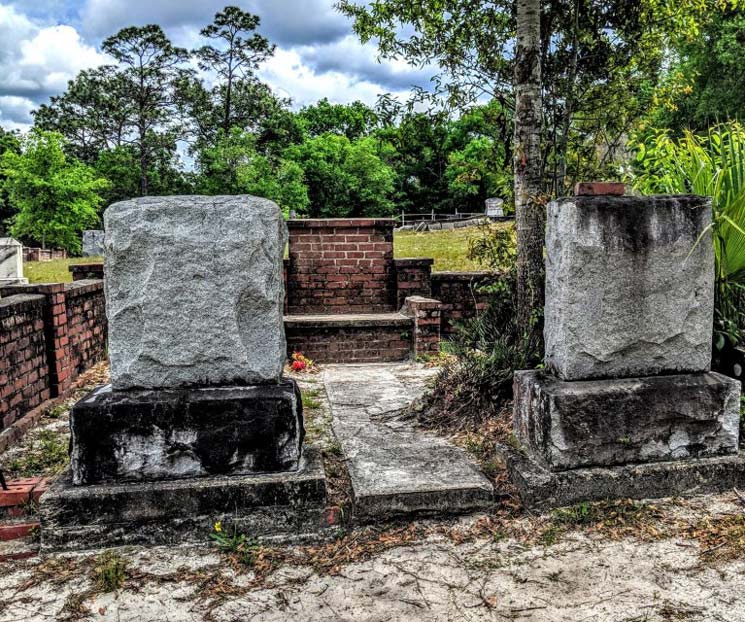
What might well be America’s most famous Devil’s chair, in Cassadaga-Lake Helen Cemetery, Florida. (Photo: Orlando Adventuring)
Unlike the intricately carved specimens found in some cemeteries, this Devil’s chair at first seems disappointingly plain. It’s a redbrick bench built into a redbrick wall that surrounds two gravestones. The tombstones’ inscriptions face the chair, each commemorating a woman named Thatcher. The only thing that really seems disturbing about the site are the pentagrams and words like ‘Lucifer’ scratched into the wall and bench.
This Devil’s chair is probably, however, America’s most famous. Every Halloween and on any Friday the 13th, large numbers of young people descend on the cemetery and try to sit in the chair, to the great annoyance of nearby residents. Residents and police guard the graveyard on these nights, turning back or arresting young adventurers. Youngsters have been accused of vandalising gravestones, throwing paint at houses and bothering locals by asking if they can direct them to Casper. The police have detained hundreds over the years.
Several legends are attached to the chair. One claims that if you leave a can of beer on the bench and come back the next morning, you’ll find the beer has been drunk – according to some, without the can having been opened. Another piece of folklore states that if you sit in the chair at midnight, you’ll meet the Devil himself, who’ll be quite happy to chat with you. Some claim the Evil One built the chair and that the things he’ll whisper to you in the witching hour will haunt you forever. Others maintain that if you lower yourself onto the seat, the Fiend will appear to you at midnight some time in the next few days, wherever you might be.
What no doubt adds to the attraction of this Devil’s chair is the fact that Cassadaga, the small town about two miles down the road, has been home to a community of spiritualists since around 1875. Sometimes called the ‘Psychic Capital of the World’, the town boasts a spiritualist church, mediums who’ll do readings for you and new-age shops. It seems the community has vacillated over recent decades between using the influx into the town around Halloween to boost the local economy and resenting the invasion of often rowdy tourists with ghoulishly stereotypical ideas about the place. But attempting to make it to the Devil’s chair by midnight is considered a no-no by virtually everyone.
The story locals tell about the ‘Devil’s chair’ is more poignant than legends of beer-guzzling demons, but no less spooky. In 1926, a 90-year-old man lost his wife and daughter in a house fire. The man, who had no other relatives, had the bench built next to their graves so he could spend as much time as possible near their burial places. He’d visit every day, sitting for hours on his chair. (He’d had the names carved facing the seat so he could gaze at them.) After some time, locals began to view him as eccentric. Though some mocked him, most were tolerant of the grief-stricken aged man.
About 11.00 pm one Halloween night, two youths – perhaps forerunners of the many who’d later descend on the graveyard – were sneaking around the cemetery. They spotted the old man crying on his bench and – concerned about him being there so late – went to tell the police. The police officers looked at them in shock and confusion.
‘What are you talking about?’ one said. ‘That old man passed away a few days ago.’
Number Two: Devil’s Chair (Baird Chair), Highland Park Cemetery, Kirksville, Missouri
This ornate, lovingly sculpted and moss-speckled chair – with the word ‘Baird’ chiselled into it – is associated with a terrifying legend.
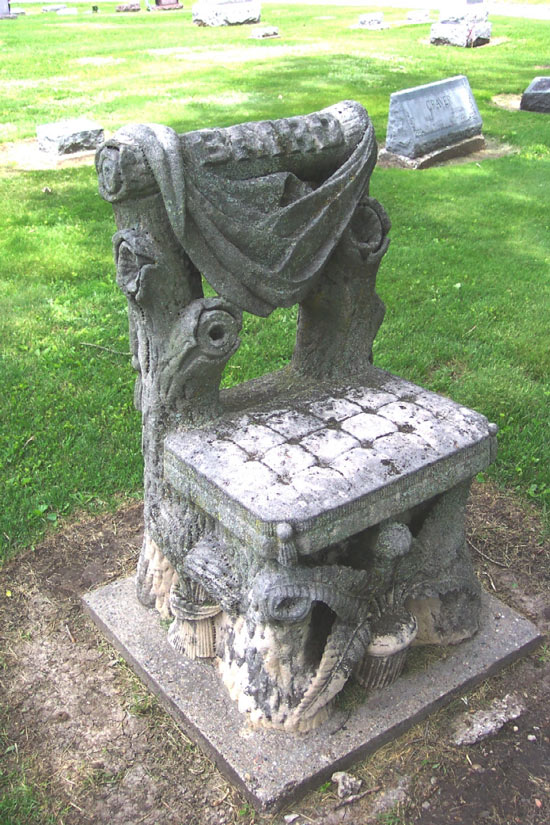
The Baird Chair, a famous Devil’s chair in Kirksville, Missouri. (Photo: David Oaks)
Local folklore contains dire warnings for those foolish enough to sit on the chair at midnight or on certain nights like Halloween. The first time you sit on the chair, you’ll suffer a string of bad luck. If you’re crazy enough to go back and sit on it again, a curse will be placed upon you. But the scariest fate awaits those deranged enough to park themselves on the Devil’s chair a third time. If you do so, an undead hand will emerge from the adjacent grave, seize you and – ignoring your screams – drag you down to hell. Other legends, however, say those who sit in the Baird Chair will be rewarded for their courage.
The seat isn’t actually a traditional mourning chair, but rather serves as a tombstone. John C. Baird was a stone mason and businessman, dealing in marble funerary monuments along with his partner, a Mr Grassle. It seems that Grassle, on a trip to Italy, saw a carved chair among some ancient ruins. Admiring its workmanship, Grassle sketched it and sculpted his own version when he got home. Grassle couldn’t, however, help adding some typical Victorian features – such as the ‘memento mori’ symbol of a discarded piece of fabric draped over the seat’s back, representing us slipping out of our ‘fleshy garments’ when we die.
Grassle and Baird showed off the chair at their marble workshop to draw in customers. In 1891, the Kirksville Weekly Graphic enthused over the ‘mosaic chair that attracts general attention. It is the latest product of Mr Grassle’s chisel.’
It seems Baird and his wife decided the impressive piece of sculpture should be used for their own monument. Mr Baird, however, couldn’t have been buried before 1914 as in that year he’s listed as one of the elders of the local Presbyterian church.
Number Three: Witch’s Chair, Brookside Cemetery, Tecumseh, Michigan
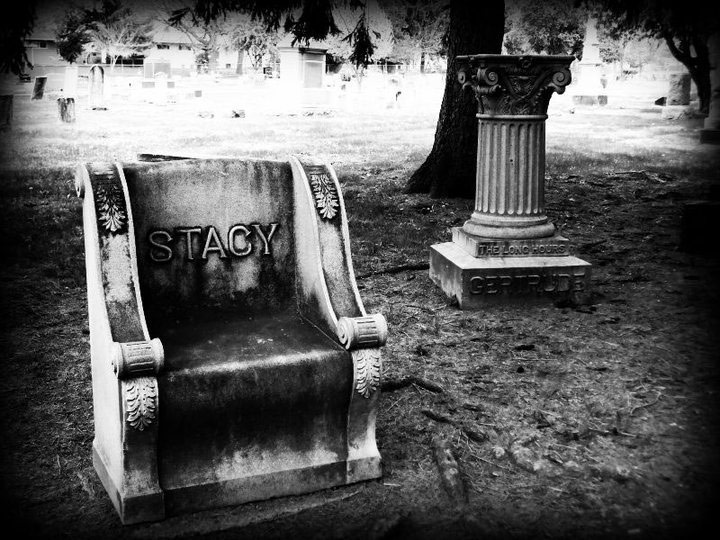
Would you sit in the witch’s chair in Brookside Cemetery? (Photo: Dawn Dubois)
Brookside Cemetery is a somewhat spooky and atmospheric graveyard – dating back to 1853, it contains many old settlers’ tombs. If you were to walk towards the back of the burial ground, you’d find the Stacy family plot, which includes an ornate granite mourning chair.
The Stacys were prosperous – Mr Stacy was a judge and he and his wife Mary had five children. After the judge died, Mary visited his grave every day for 17 years, sitting for hours on the granite seat.
The chair’s connection with witches comes about because one of the Stacey children, Loanna, never married and came to be considered the ‘town spinster’. Old widows and spinsters – often being both needy and vulnerable – tended to be resented in their communities. Scapegoated for things that went wrong, they were sometimes accused of causing these misfortunes through witchcraft.
In Tecumesh, a number of occurrences led to Loanna being labelled a witch. The fact she long outlived her parents and siblings generated suspicion. A spate of locals getting sick and their farm animals mysteriously dying also saw fingers jabbed toward Loanna.
A ghost – some say Loanna’s, some say Mary’s – has been spotted on the granite seat. People have also seen Loanna floating through the corridors and halls of the family mansion, which still stands in the town. But what does local folklore claim will happen if you’re rash enough to sit on the ‘witch’s chair’? The answer is simple – shortly afterwards, you’ll die.
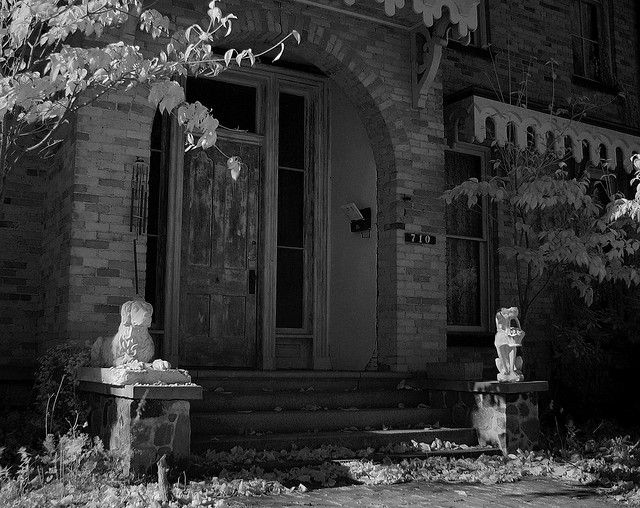
The Stacy mansion – said to be haunted by the ‘witch’ Loanna’s ghost. (Photo: Aurora Momcilovich)
Number Four: Witch’s Chair, Southside Cemetery, Pontiac, Illinois
Southside Cemetery – a creepy burial ground of moss-covered tombstones, elaborate grave markers and subsiding mausoleums – is a place of much legend and folklore. Its proximity to the Vermilion River has seen the graveyard flooded and coffins borne off downstream. The cemetery also hosts a ‘goblin tree’ – during the day the tree simply appears old and knotted, but at night reveals the outline of a hideous evil face.
It’s not surprising that such a location boasts a witch’s chair. The chair is said to mark the grave of a witch hung for murdering her own child. Some say that if you stand on the grave at midnight, you can hear the crying of the witch’s baby. Another legend states that if a young person sits in the chair and reads the epitaph carved upon it aloud, they’ll die before their 18th birthday. This pleases the child killer resting under the soil.
Apparently, on Halloween night in 1975, a youngster visited the cemetery with a friend. He sat in the chair and started reading out the epitaph, but – before he could finish – the back of the chair broke off and tumbled to the ground. The terrified youths sprinted from the graveyard. They were, however, curious enough to go back the next day. The chair was whole again, with no signs of any ruptures. According to another piece of folklore, if you sit in the chair and rub the arms, you’ll hear the witch scream.
A bit of sober investigation soon dispels these myths. There are no records of anyone being hung for child murder or a witch in Pontiac around the time the grave’s occupant died. And it would actually be impossible to read out the tomb’s inscription as most of the words carved on the concrete chair have worn away, with much of the damage probably caused by overexcited teenagers. The words ‘Perry’ and ’49 years’ are visible, along with – possibly – the word ‘missed’. If the ’49’ refers to an age, the woman would have been a little old to be the mother of a new born. But such facts haven’t stopped generations of youngsters daring each other to sit in the ‘witch’s chair’ and spreading outlandish tales about it.
Number Five: Devil’s Chair, Greenwood Cemetery, Decatur, Illinois
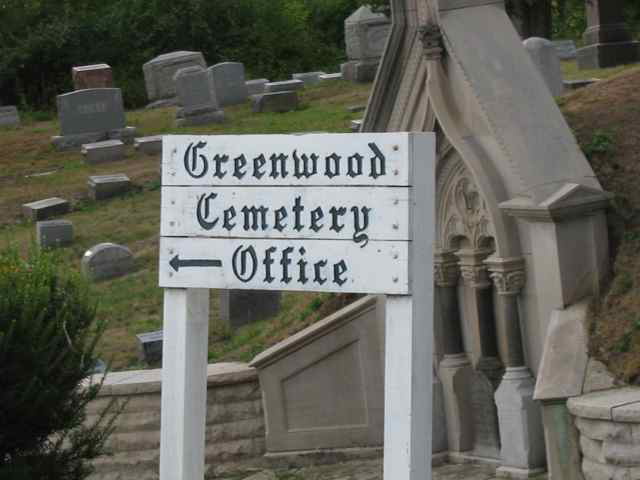
Greenwood Cemetery in Decatur, Illinois – allegedly one of the most haunted graveyards in America. (Photo: a grave interest)
Greenwood Cemetery is said to be one of the United States’ most haunted. Originally a Native American burial ground, the graveyard was used by settlers in the early 1800s and would later see masses of Civil War dead interred. Though once an attractively wooded, garden-style cemetery, the bankruptcy of the company that ran it led to the graveyard becoming overgrown and neglected in the 1920s. Gangs roved it after dark and cults carried out bizarre rituals there. Maybe this long and sometimes sinister history has fuelled the graveyard’s reputation as a centre of ghostly occurrences.
People have spotted spook lights and witnessed phantom funerals. A young woman who was engaged to a bootlegger but died before she could marry him was buried in her wedding dress and is said to haunt the cemetery in her bridal attire. Voices, crying and screams have been heard from a mass grave used for the burial of unclaimed bodies from a demolished mausoleum. Another mass grave – of Confederate soldiers, some of whom were rumoured to be not quite dead when they were interred – was disturbed when a nearby river flooded. Soon afterwards, reports began of ghostly lights, glimpses of phantoms in Confederate uniform, and moans and wails coming from the mound where the bodies salvaged from the river were reburied.
Greenwood Cemetery also, as you might expect, contains a Devil’s chair. This mourning chair is of a naturalistic design, with its stone carved to resemble a tree trunk and branches. The name ‘Houston’ is etched into the seat. The chair would have simply been used for family members to sit on when visiting the next door grave, but the object’s straightforward purpose hasn’t stopped the most incredible legends growing up.
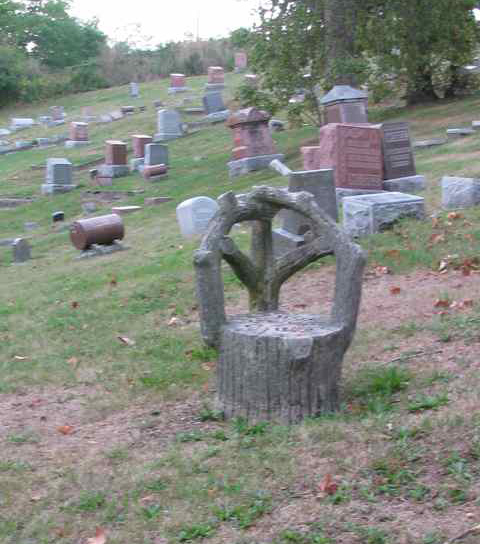
The Devil’s chair in Greenwood Cemetery, Decatur, Illinois. (Photo: a grave interest)
Stories claim those who sit on the chair will die within one year or bring bad luck upon themselves. On the contrary, other tales state that those brave enough to place their backsides on the seat will be rewarded with good luck or riches. Another legend asserts that if you sit on the chair at certain times – midnight or Halloween, presumably – the Devil will appear and grant you anything you desire. But you can only enjoy his munificence for seven years. At the end of this period, the Evil One will return and demand your soul as payment.
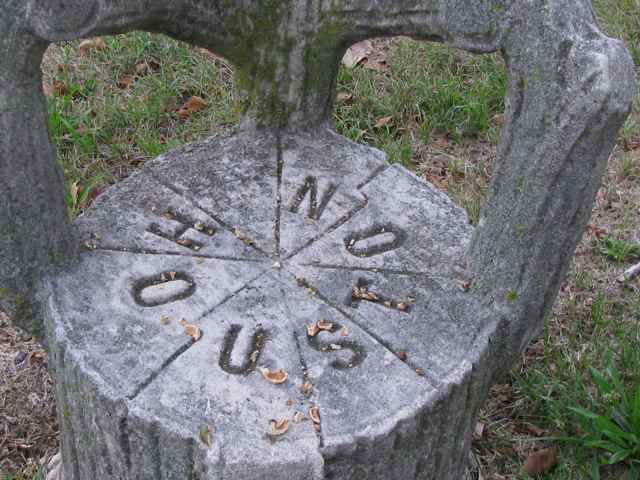
The engraved seat of the Devil’s chair in Greenwood Cemetery. (Photo: a grave interest)
Number Six: Devil’s Chair, Union Cemetery, Guthrie Center, Iowa
Local legend says that if you have psychic abilities and sit in this chair, you’ll hear the dead talk. Other folklore, however, states that sitting in the seat will result in bad luck. More disturbingly, several stories link the chair with the Devil. He’s said to appear in it every Friday the 13th and – more puzzlingly – every Friday the 17th, at precisely 3.00 a.m. on both dates. Some claim that if you position yourself upon the seat, the Fiend will grant you magical or psychic powers, but only if he likes you and feels he has a great use for you. If you experience strange smells in the vicinity of the chair, it’s a sign the Evil One’s close by.
The ‘Devil’s chair’ is located between two graves though its uncertain which it belongs to. It’s similar in design to the Baird Chair, but is cast from cement rather than carved from stone. Though the Union Cemetery opened in 1885, it seems all the wild stories connected with the dastardly chair only go back about 35 years.
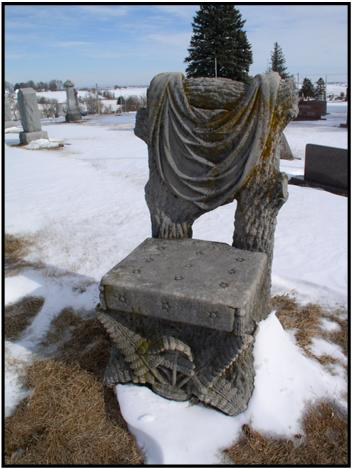
The Devil’s chair in Guthrie Centre, Iowa. (Photo: Blackhawk Paranormal Investigations)
Number Seven: Devil’s Chair, Congress Park, Saratoga Springs, New York
Saratoga Springs – a resort town in New York State – has quite a collection of ghosts. Civil War phantoms have been spotted on the site of the Battle of Saratoga, a few miles from the town. But many of Saratoga’s spooks have more to do with pleasure than conflict. Saratoga – thanks to the fame of its medicinal springs – became a popular tourist destination in the late 1700s. Visitors also flocked to Saratoga for less wholesome reasons as the area gained a reputation for casinos and horseracing.
One of the town’s most glamourous venues was the Canfield Casino, built by a boxer called John Morrissey in the late 1800s. Now a museum, the Casino, however, seems reluctant to let go of its hedonistic past. Spectres of the guests who drank and gambled there have been seen as has the ghost of John Morrissey. Visitors have smelt mysterious wafts of cigar smoke. A woman in Victorian attire is said to wander the building – in 2007 she walked up to a group of tourists and asked them a question. An upsurge in hauntings apparently occurred between 2007 and 2010, a phenomenon some blamed on an exhibition at the museum featuring the clothes of prominent Victorian ladies. An unseen entity slapped a glass out of a guest’s hand while another sent the lid of a rubbish bin sailing through the air. The lid landed between a museum volunteer and employee.
Perhaps a strong connection with the past accounts for the legends centred on Saratoga Springs’ Devil’s chair. This Devil’s chair is unusual as it isn’t in a cemetery. It can be found on the corner of the city’s Congress Park. The chair was intended to be the corner stone of a Presbyterian church, but the Presbyterians found out about plans to build a casino right next to their new house of worship. Believing gambling to be the Devil’s work, they fled, but left behind some stones, one of which was chair-shaped.
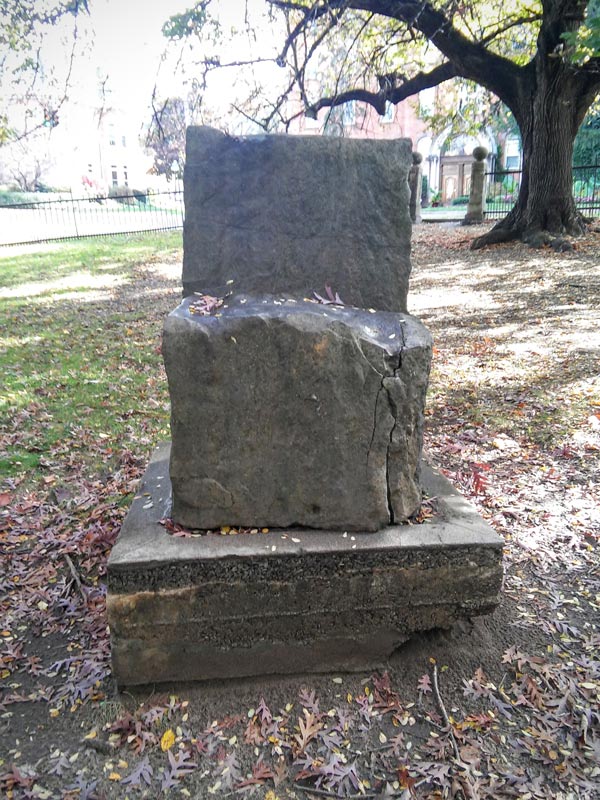
The Devil’s chair in Saratoga Springs can supposedly transport you back in time.
It’s said that if you sit on the chair, you’ll be transported back to the early 1900s. Perhaps this means you can join in the good times Saratoga enjoyed before an anti-gambling law of 1907 brought them to an end. Maybe the Devil’s chair would also enable you to teleport back to the present, leaving any gambling debts in the past. Some claim, however, that the chair will only transport you if you’re a teenage girl and sit on it after midnight.
Honourable Mentions and More Devil’s Chair Folklore
The examples above are just some of the Devil’s chairs found across the United States. While some cemeteries have removed so-called ‘Devil’s chairs’ due to them being magnets for vandalism and anti-social behaviour, quite a few of the chairs that remain are surrounded by interesting folklore.
Oakwood Cemetery in Syracuse, New York, contains a child-sized Devil’s chair and legends have grown up around the Duncan Monument in Fletcher Cemetery, Ohio. The spooky-sounding Empty Chair in Hope Cemetery, Barre, Vermont – an armchair-like structure with the name ‘Bettini’ carved into it – has, unsurprisingly, generated local myths.
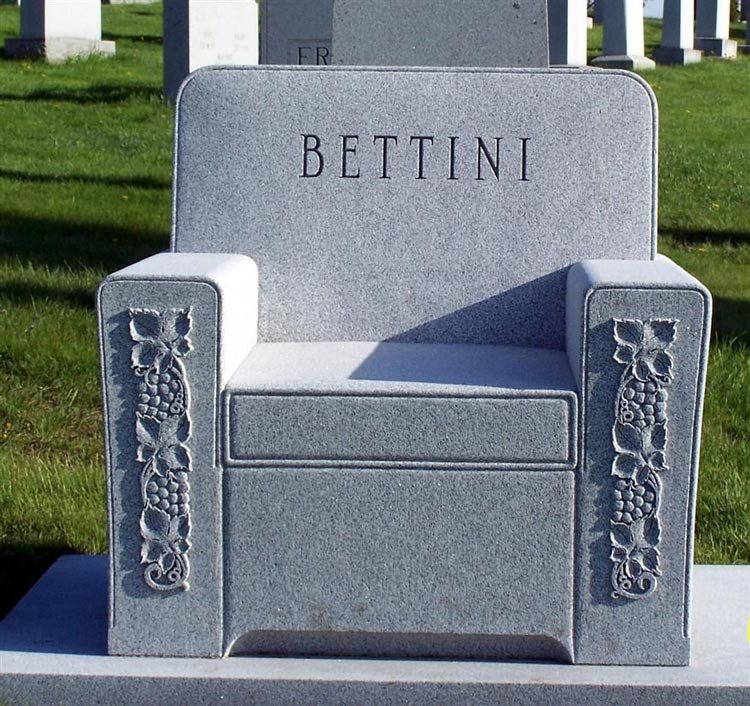
The spookily named ‘Empty Chair’ in Hope Cemetery, Barre, Vermont. (Photo: Stacy Artis)
A number of Devil’s chairs are said to exist in the cemeteries of New Orleans, including a wrought-iron Devil’s Throne. Apparently, the legendary voodoo master Dr John sat in this chair, thereby learning many rituals and the secrets of zombification. Texas is home to some particularly horrifying Devil’s chairs. If you sit on a certain cemetery seat in Galveston, you’ll have visions of all your family members suffering terrible deaths. If a couple sit on a Devil’s chair in Marshall and one asks the other to marry them, the pair will be married, but only for one day after which they’ll die.
Another chair in Marshall is known as the Devil’s Hot Seat. Anyone who sits in it is thereafter unable to tell a lie so all their dirty secrets are spread throughout the state. This chair is greatly feared by criminals, politicians and lawyers. Maybe the most terrifying Devil’s chair in Texas is in Jefferson. Anybody sitting in it will immediately lose control of their bowels. More seriously, they are then said to be cursed to lose a limb or suffer a lifetime of disability. Somewhere in Houston there’s rumoured to be a Devil’s footstool. If you lower yourself onto this child-sized bench, you’ll gain immense popularity but at the cost of giving Satan your soul.
A Devil’s chair in Santa Fe, New Mexico, is reputed to have had tragic consequences for those who constructed it. The man who made the chair lost both his hands so his son finished it off, losing three fingers in the process. One of the men who delivered it to the cemetery lost an arm while another delivery worker who sat in the chair to check its strength died on the spot. If a visitor to the graveyard touches the chair, they’ll lose the finger they prodded the seat with.
In Ocean City, New Jersey, local folklore says a Devil’s chair was once stolen from a cemetery. The thief was detected when they were found sitting in the chair dead in the middle of the street. A Devil’s chair in Gettysburg, Pennsylvania, however, seems more benign than most of its counterparts. If a woman struggling to get pregnant sits in the seat, she’ll be expecting within a year.
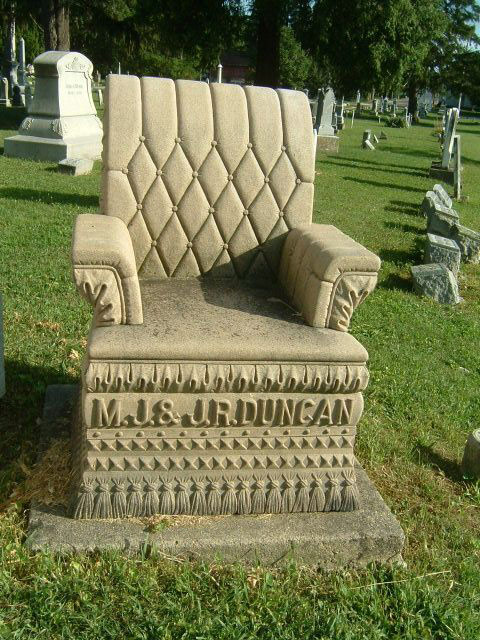
The Duncan Chair in Fletcher Cemetery, Ohio – legend says that if you sit in it, you’ll die before the year is up. (Photo: Julie Ette)
A complex knot of folklore seems to have grown up around Devil’s chairs in general, a folklore whispered through high schools and colleges and bandied about on social media. You should never, apparently, let a single drop of blood fall on such a chair as this will allow the Devil to drag you straight down to hell. For this reason, women should never sit on a Devil’s chair during their periods. The Devil will also claim your soul if you are presumptuous enough to ask him to appear rather than waiting for him to manifest at his pleasure. And you must never sit in such chairs and mock the Evil One – if you do, you’ll drop into a deep depression and be dead in seven days.
Devil’s chairs are notorious for bringing on mental illness. A psychic who sat in the Baird Chair is said to have lost her ability to speak and is now in a psychiatric hospital, having never come out of the trance she fell into. You should never have your photo taken when sitting in a Devil’s chair as it will be the last photograph of you ever made. Pregnant women especially should avoid sitting on these seats – as the child they’re carrying will be cursed. Rumour has it that the mother of a serial killer unwisely perched on such a chair. And, most importantly of all, you should never have sex on a Devil’s chair – any child you conceive may grow up to be the Anti-Christ!
Just to make things more confusing, though, some myths state that any curses associated with a Devil’s chair will not apply to the person who sits in the seat, but rather the one who dared them to do it.
So it appears an incredible tangle of folklore has enmeshed itself around items that were once simply intended to be grave markers or functional cemetery furniture. What’s more astonishing is that this folklore is quite new – in many cases just a few decades old. But what might have inspired such legends and what could have prompted them to spread so quickly in the modern United States? We’ll go searching for answers in the next sections.
Haunted or Cursed Chairs Are Common in Folklore
Though the folklore around Devil’s chairs in American cemeteries is far from ancient, older legends can be found that predict tragic or at least magical consequences for those sitting in ‘cursed’ or ‘haunted’ seats.
The Busby Stoop Inn, Yorkshire, England, was once home to an infamous chair. According to local folklore, anyone who sat in it soon died. The chair is said to have been the favourite seat of the pub’s landlord, a notorious criminal who was hung in 1702 for battering his father-in-law to death. Before going to face the rope, the landlord was allowed one last drink in his pub and he, of course, enjoyed it in his beloved chair. When he got up, he cursed the seat and there are numerous tales of people foolish enough to have sat in the chair who met their ends soon after.
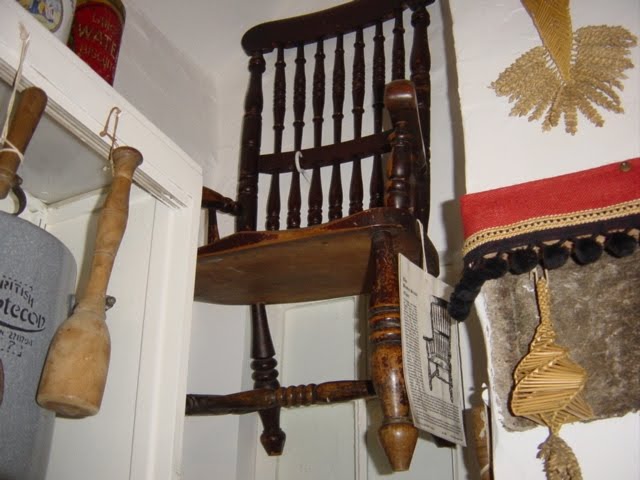
A cursed chair that was once housed in the Busby Stoop Inn, Yorkshire – sitting on it meant death. (Photo: TheHauntedPalace)
In England, there are even natural features of the landscape known as Devil’s chairs. In Shropshire, a rocky outcrop – the Devil’s Chair – is the subject of local legends. Some say the protrusion was built by the Fiend himself or that he was carrying a load of rocks in his apron and lay down for a rest. When he got up, his apron strings snapped and the rocks tumbled out, forming the Devil’s Chair and the smaller outcrops surrounding it. Apparently, you can still smell brimstone coming off the rocks on hot days. On Midsummer’s Night, Satan is said to seat himself on the Devil’s Chair and summon his local supporters – witches and wicked spirits – who then select their king for the next year. In Ulverston, Cumbria, there’s a feature known as the Devil’s Armchair – a chair-like rock formation big enough for four adults to sit in. Whether it’s natural or manmade is not known.
There are various legends of haunted household chairs, which will inflict consequences on those brash enough to sit on them. People sitting in such chairs might feel an intense chill or suffer nausea or hot sweats. The chair might start vibrating or even throw them out. Others receive tragic news on the day they sit on the seat. Some chairs won’t let a person sit in them unless their death is approaching. Certain chairs supposedly scoot around floors with supernatural energy.
A 200-year-old ‘chair of death’ – kept in the Baleroy Mansion, Philadelphia – is alleged to have killed four people who sat in it and will kill anyone else reckless enough to do the same. The chair – said to have once been owned by Napoleon – is apparently haunted by a young woman called Amanda, who appears in a red haze. The chair is thought to have been constructed by an evil warlock in the 18th or 19th century. The Baleroy Mansion is viewed as one of the most haunted houses in the US, with manifestations of ghosts, angels, demons and jinn being reported.

The Devil’s Chair, part of the Stiperstones, Shropshire – does the Fiend seat himself upon it at Midsummer? (Photo: Jeremy Bolwell)
On the island of Torcello, near Venice, is a stone seat known as the Throne of Atilla. Probably a magistrate’s or bishop’s chair, this seat is actually thought to have been made around 100 years after the death of the famous king of the Huns. A legend says that if a young woman sits in the seat, she’ll marry within a year; another piece of folklore asserts that all who sit in it will return one day to Torcello.
These examples show that folklore about magical or sinister chairs is widespread and that much of it predates the Devil’s chair legends of America’s cemeteries. The stories above all link certain chairs with the Devil or ghosts and/or claim there are consequences for people who sit on them. In this way, these tales are similar to the legends that have arisen in connection with chairs in US graveyards. Could it be that older myths have been resurrected or reapplied to express the concerns, fears and desires of modern American youngsters? Might these older folktales and archetypes have transferred their focus to previously innocuous cemetery benches and grave markers?
But we still might ask why such a process should have occurred. Why would American youths bother to build up such elaborate legends about their local graveyards and why – considering what these legends say – would they even want to sit on Devil’s chairs? Most of the folklore promises dire results for those who park themselves on these benches and – even when good things are guaranteed – this is often at the price of trading in one’s soul. The answer might lie in a phenomenon that’s been labelled legend tripping.
Devil’s Chairs and Legend Tripping
Legend tripping is an activity in which groups of young people visit spooky or threatening places – such as caves, tunnels, graveyards and old houses – associated with tragedies or the supernatural. Engaging in legend tripping is a way for youngsters to demonstrate their daring and courage as well as their independence from parents, teachers, preachers and other authority figures.
Legend tripping is often linked to a phenomenon called ostentation, in which people act out pieces of legend and folklore or the contents of books or films. Ostentation is a kind of game in which the borders between reality and fantasy become fuzzy. Going to a creepy cemetery at night and ‘role playing’ local legends by sitting on ‘cursed chairs’ is a copybook example of both ostentation and legend tripping.
Bill Ellis, an American academic specialising in the occult who has studied legend tripping, sees it as having positive features, such as encouraging creativity and providing a fairly safe outlet for rebellious feelings. Ellis argues legend trips are ‘ways of expressing independence from adult norms and the kind of social mores that govern people in school, society or church. It’s an opportunity to go visit the Devil’s half-acre, which I think people have to do to prove they’re not social robot adults.’
Ellis states, ‘The irony is (legend trips) are so commonplace. But when they come to the attention of some crusader, who starts talking to the police, they begin to think it’s Satanists teaching this stuff to kids. So these things go from trivial to “a menace that threatens our country”.’
Examples of legend tripping can be found in many parts of the world – and the results have occasionally been dramatic. In the 1950s, hundreds of children invaded a Victorian cemetery in Glasgow determined to hunt down a vampire. This incident led to media panic, debates in Parliament and even a law being passed to limit the availability of American horror comics. In 1970s London, rival groups of young people suspected a vampire was lurking in Highgate Cemetery. The case got into the press and a TV programme was made, resulting in a mass invasion of the graveyard one Friday the 13th.
Rather than vampires, American youngsters seem to have fixated on long-disused mourning chairs and have woven a hysterical though impressive mythology around them. I also can’t help thinking that the rise of the horror film genre in the 1970s and 80s added to this trend. It’s interesting that the same period witnessed the rapid growth of Christian fundamentalism, which must have made all the associations of mourning chairs with the Devil even more thrilling.
But can legends of Devil’s chairs be completely dismissed with these rational arguments? I wonder how many of us would feel rational looking at the gothic contours of an empty beckoning seat in a midnight cemetery while remembering all the terrifying lore we’ve heard.
As a young researcher, Bill Ellis sat on the Stone Couch, an allegedly cursed roadside bench near the town of Weatherly, Pennsylvania. Some say a hex was put on it by a Native American woman whose baby died there. The first time you sit on the couch, you’ll hear an infant crying. The second time, you’ll receive a ominous warning, like being involved in a non-fatal car wreck. After the third time, you’ll die.
Ellis sat on it twice – and after the second time lost much of his hearing. He didn’t sit on the bench again. He saw no reason to take the risk.
(This article’s main image shows an ornate bench in Lake View Cemetery, Seattle, Washington. Photo: Joe Mabel)

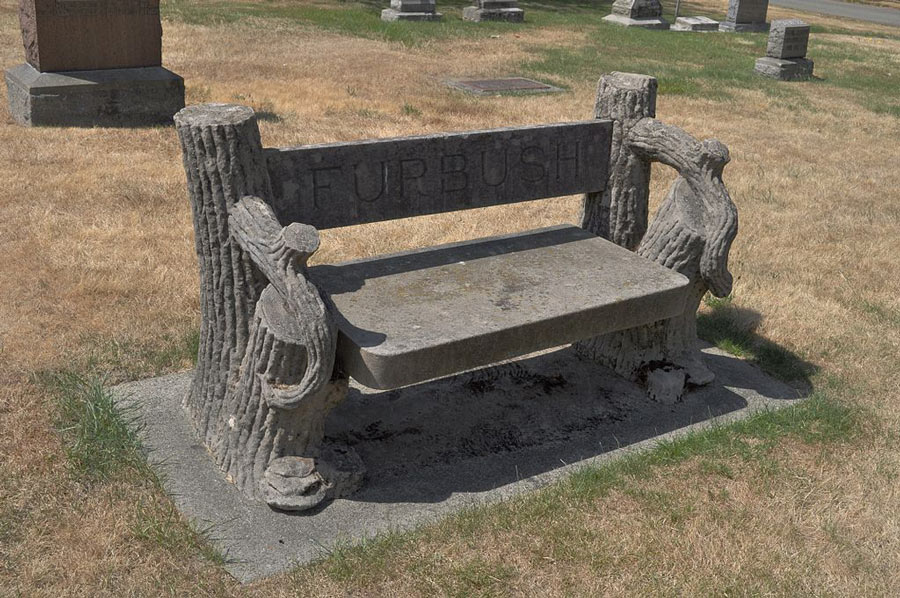
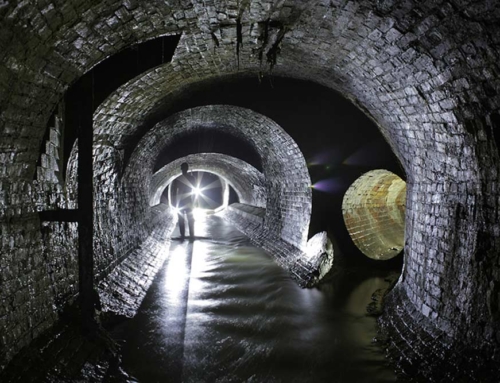
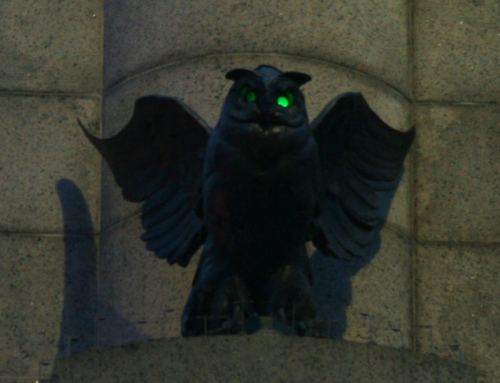
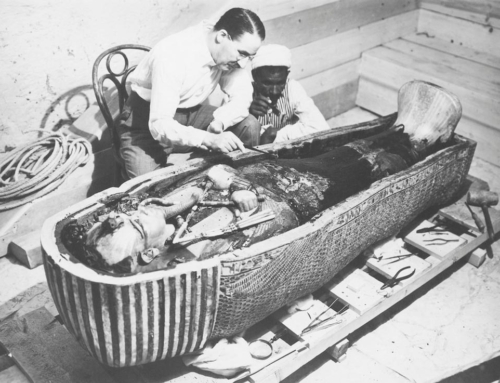
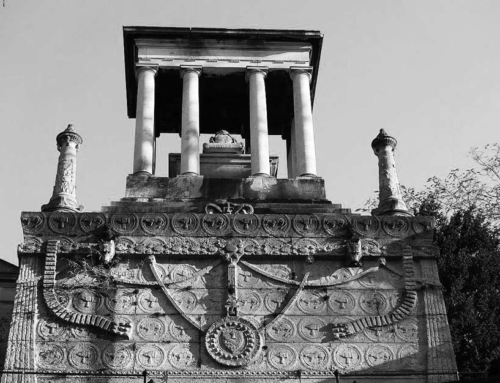
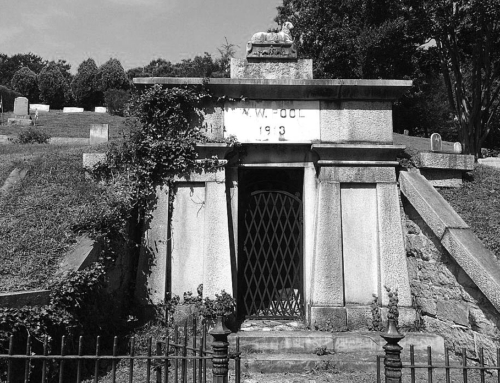
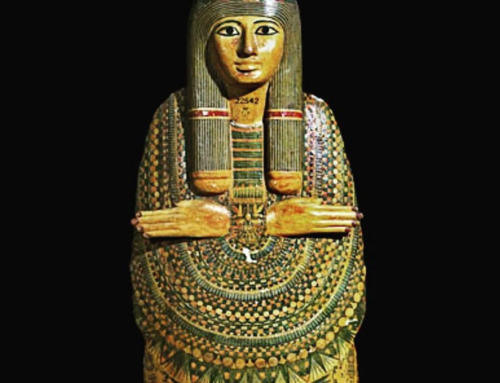
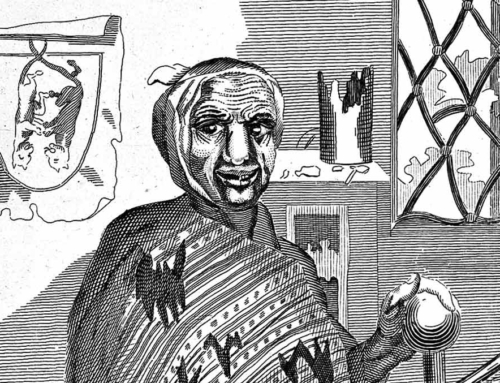
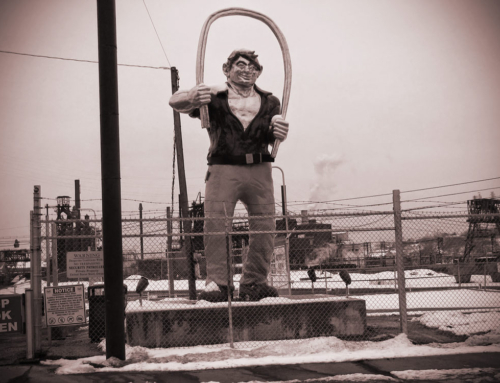
Leave A Comment